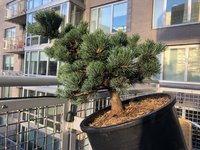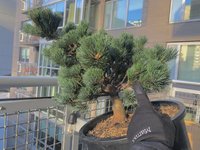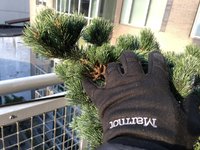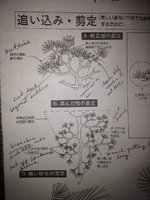Hello BonsaiNut!
Last month I picked up a nursery Japanese White Pine 'Kinpo' grown from Iseli. Just a beautiful tree. I am new to bonsai and wanted to branch out beyond junipers, decided to go for a pine, and would up with this one. Little did I know how challenging Japanese White Pines are. Anyway, over the past month, I have poured over the internet, this site/these forums, and a couple of books looking for advice on what to do to get this tree trimmed down/reduced properly so that it doesn't outgrow itself in the coming years, as I understand JWP have a tendency to do with their rare backbudding. The tree is currently too dense and I want to reduce its foliage and optimize its branching structure for bonsai.
Included are 5 images:
1. Tree after first of a series of minor trims. You can faintly see the graft union. As far as I can tell comparing to other posts on this forum, the graft is decent. I am not sure onto what rootstock Iseli grafts their JWP (e.g., JBP, scots, etc.). But tree is altogether too dense and I hope to fix that.
2. Showing what I believe to be the front where trunk base appears widest.
3. Showing how I plan to wire lowest right branch to expose trunk better. This picture also exposes some of the many branches arising from first whorl. Some are pointing diagonally upward and I do not think I will ever be able to wire them into a correct horizontal/downward position--thinking I must remove them?
4. A ton of tiny shoots/branches emerging below apex of tree. Not sure whether these should be trimmed or whether it would be better to actually chop the trunk that these are emerging from, making these form a new broad apex (collectively their foliage makes a decent dome).
5. Partially wired bottom right branch. This picture displays some of the main questions I have about how best to take care of this tree:
Your insights are greatly appreciated! For reference, I am based in NYC (Zone 7b). Thank you for reading.





Last month I picked up a nursery Japanese White Pine 'Kinpo' grown from Iseli. Just a beautiful tree. I am new to bonsai and wanted to branch out beyond junipers, decided to go for a pine, and would up with this one. Little did I know how challenging Japanese White Pines are. Anyway, over the past month, I have poured over the internet, this site/these forums, and a couple of books looking for advice on what to do to get this tree trimmed down/reduced properly so that it doesn't outgrow itself in the coming years, as I understand JWP have a tendency to do with their rare backbudding. The tree is currently too dense and I want to reduce its foliage and optimize its branching structure for bonsai.
Included are 5 images:
1. Tree after first of a series of minor trims. You can faintly see the graft union. As far as I can tell comparing to other posts on this forum, the graft is decent. I am not sure onto what rootstock Iseli grafts their JWP (e.g., JBP, scots, etc.). But tree is altogether too dense and I hope to fix that.
2. Showing what I believe to be the front where trunk base appears widest.
3. Showing how I plan to wire lowest right branch to expose trunk better. This picture also exposes some of the many branches arising from first whorl. Some are pointing diagonally upward and I do not think I will ever be able to wire them into a correct horizontal/downward position--thinking I must remove them?
4. A ton of tiny shoots/branches emerging below apex of tree. Not sure whether these should be trimmed or whether it would be better to actually chop the trunk that these are emerging from, making these form a new broad apex (collectively their foliage makes a decent dome).
5. Partially wired bottom right branch. This picture displays some of the main questions I have about how best to take care of this tree:
- All over the tree I have branches that fork into 3, rather than the ideal 2. Two of such branches are wired in this picture. If I had caught these branches forming 1-2 years ago (whenever it was), I would have reduced them to 2. But now that they are here, I worry that by removing them all I would be removing "too much." What is the best course of action: leave them as forks of 3, cut the middle strongest branch leaving 2 symmetric thinner branches (best aesthetically), or cut a side thin branch leaving 2 asymmetric thick and thin (perhaps best for pulling sap/energy to this bottom part of tree?).
- As demonstrated on a few of the thicker branches, not only are there tiny shoots/needle tufts at the ends of branches, there are also needle clusters emerging directly from the branch itself. This is not something that I ever see when I look at pictures of JWP and it is not as aesthetically pleasing as the "clean" thin branches with only needles tufts at the end. As a bit of an experiment, I treated one branch by cutting all of the needles just above their bases where they emerge directly from the branch (bottom right of image), and on another branch I left them intact. What are your thoughts on this?
Your insights are greatly appreciated! For reference, I am based in NYC (Zone 7b). Thank you for reading.







